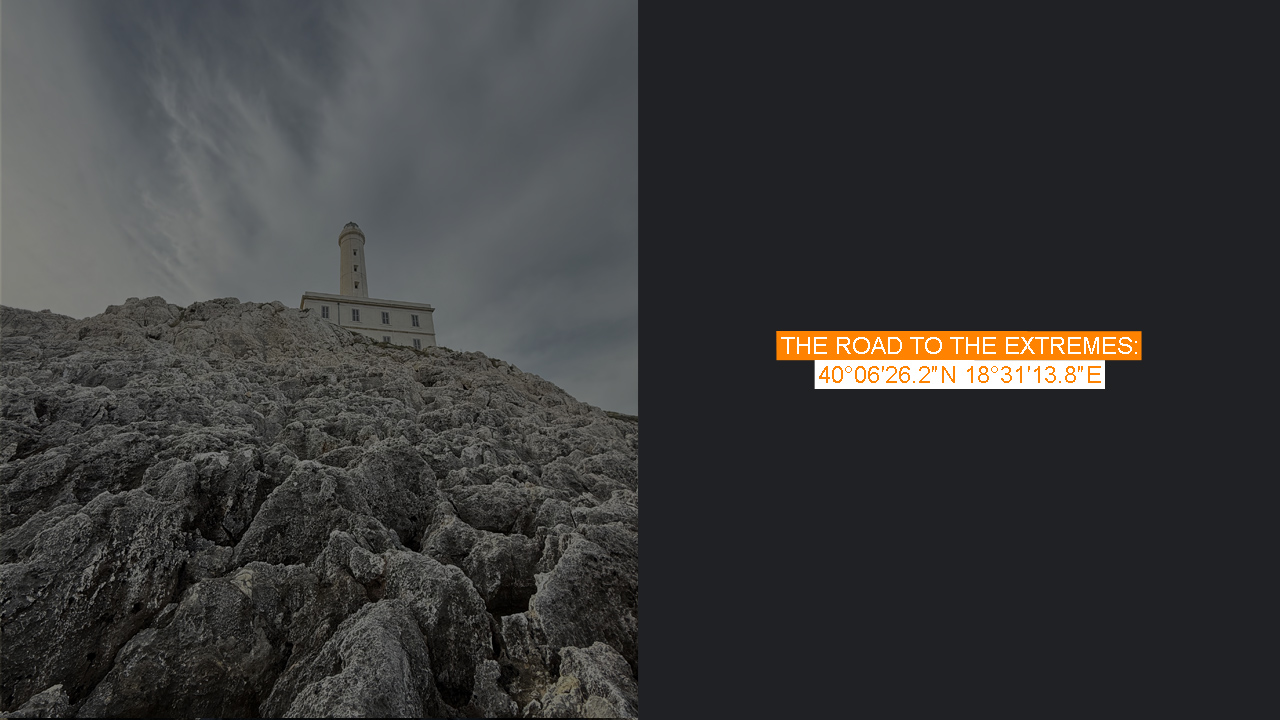The easternmost point of Italy is surprisingly far east. In fact, it lies farther east than Stockholm, Vienna, and even the entire country of Slovenia. Reaching this remote spot wasn’t exactly a walk in the park. My journey started after I had already visited the southernmost point of mainland Italy in Calabria. From there, I endured a six-and-a-half-hour train ride to Lecce—a city of around 100,000 inhabitants and a former provincial capital. Situated on the Salentine Peninsula, Lecce has a history spanning over two millennia, and it was here that my adventure to Italy’s easternmost edge truly began.
I weighed my options carefully. Since I had committed to a car-free trip, renting one was out of the question. Buses seemed unreliable, so the train was the best bet. It would take me to the coastal town of Otranto, leaving me with just seven kilometers to the final destination.
On a crisp January morning, I found myself at Lecce’s train station, waiting for the 9 AM departure. Dressed in running shoes, white shorts, and a neon green jacket, I undoubtedly stood out. Whether my fellow passengers were heading to work or returning home from a night shift, I couldn’t tell—but I knew I didn’t quite blend in. The train itself was an old diesel-powered relic, and I could only imagine how suffocatingly hot it must get in the summer.
The conductors, despite the language barrier, were incredibly kind. They ensured I didn’t miss my transfer at Maglie, where I switched trains. The journey, lasting about an hour and forty minutes, wasn’t particularly scenic—mostly flat Italian countryside with occasional points of interest. By the time we reached Otranto, only a handful of passengers remained. As expected, there were no taxis at the station, and trusting an uncertain bus schedule felt risky. Fortunately, I had prepared: a bottle of water and a pastiera napoletana—a delicious pie I had ordered the night before just to meet the minimum delivery amount of my pizza. With no better option, I decided to walk to the easternmost point, and in hindsight, it was the best decision I could have made. My only regret? Not grabbing extra supplies before the grocery store closed for Italy’s notorious midday break.
I had studied satellite images and hoped for a more scenic route instead of the main road, SP87. My first stop was Cava di Bauxite, an abandoned bauxite mine turned artificial lake, with striking red dunes and turquoise waters. It had been left untouched since its closure in 1976.
As I reached the parking area of this little attraction, I noticed a few other visitors heading in the same direction. However, my focus was elsewhere—toward my real goal, Faro di Punta Palascìa, the lighthouse marking Italy’s easternmost point. A faint trail seemed to lead that way. Would it take me all the way there? I had to find out. When a mountain biker emerged from that direction, I took it as a good sign. I also spotted a marker for the Via Francigena, an ancient pilgrimage route stretching from Canterbury, through France and Switzerland, all the way to Apulia, where pilgrims once embarked for the Holy Land.
One of the most remarkable things about this location is its proximity to Albania—less than 80 kilometers across the Strait of Otranto. The high peaks of the Albanian coast, including Mount Çika, were clearly visible. The scenery was breathtaking, but the trail itself proved tricky. Muddy and covered in sharp stones, it made me regret my choice of running shoes. I stepped carefully, trying not to twist an ankle. I also regretted not bringing swimming gear—the weather was unexpectedly warm, and the crystal-clear waters below were tempting.
Along the way, I passed fishing boats, tankers, and a few scattered caves. At one point, I even received a text message welcoming me to Albania’s mobile network—a reminder of how close I was to another country. After that, I switched my phone to airplane mode, just to be safe.
It took about two hours to reach the lighthouse from the train station, but with the stunning scenery and perfect weather, I could have stretched the journey even longer. The lighthouse, built in 1897, was abandoned in the 1970s but reopened in 2008. Standing 32 meters tall, it now houses a museum and a café—both, of course, closed this time of year.
I wasn’t completely alone. A couple had also made their way there, but otherwise, the place felt wonderfully secluded. I climbed down to the water’s edge to enjoy my pie and refill my bottle. That’s when a wave decided to drench my shoes—unfortunate, but not enough to dampen my spirits.
Looking around, I briefly panicked. Was the actual easternmost point closer to town? The landscape played tricks on my eyes. Consulting both my map and the terrain, I confirmed that I was indeed in the right place. Still, I felt compelled to ensure I had reached the very farthest point. The easiest way to the waterline wasn’t quite it—I needed to climb up and then down again over jagged rocks. It looked daunting, but in the end, it wasn’t as bad as I had feared.
After taking the necessary photos, I allowed myself a moment to truly soak it in. Standing at the very edge of Italy, staring at the vast sea stretching toward Albania, I felt a quiet satisfaction. The journey had been unpredictable, but that made it all the more rewarding.
The return trip felt easier. I opted for the most direct route to ensure I caught a train before sunset and made it back to Lecce at a reasonable hour. Just next to the lighthouse, up on the hill, sat a naval radar station. A little further down the road was an Italian Air Force radar facility. Otherwise, the return journey took me past open fields and roads favored by cyclists and motorbikers speeding downhill.
Before heading back, I took a quick detour to properly explore Cava di Bauxite. Its vibrant colors—deep red soil, vivid green vegetation, and surreal blue waters—were worth the extra steps. The walk back to Otranto was much easier, and with time to spare, I wandered through the town itself. It was charming, inviting, and full of character—a place I would love to visit again under different circumstances.
This trip had started as a simple mission to reach Italy’s easternmost point, but it turned into something far greater. It was a journey of unexpected discoveries, stunning landscapes, and a reminder that sometimes, the best adventures happen when you ditch the easy route and embrace the unknown.

